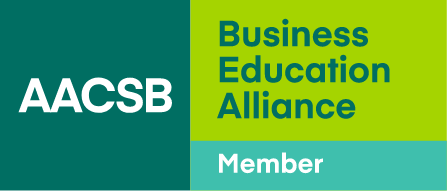Global Research Impact Framework: Exposure Draft
October 19, 2025
In 2025, AACSB partnered with nine scholarly societies to establish the Global Research Impact Task Force, charged with broadening the way business school research impact is defined, measured, and advanced across the business education ecosystem.
The task force was guided by four objectives:
- Expand the definition of research impact beyond traditional scholarly metrics.
- Identify principles for assessment that reflect meaningful , empirical, and practical contributions.
- Provide business schools and their disciplines with flexibility to determine incentives that encourage and reward evidence-based impact.
- Ensure that research impact reflects the perspectives of multiple stakeholders, including academia, industry, policymakers, regulators, and society.
To advance this agenda, the task force convened a series of roundtables, discussions, and focus groups, bringing together diverse voices from across academic and non-academic communities. This dialogue was enriched by a multi-audience survey that captured insights from faculty, deans, and other stakeholders worldwide.
The results in this exposure draft reflect the task force’s first-phase objectives: to reveal key challenges, establish guiding principles, and recommend a framework that schools can use to strengthen their research impact ecosystems. The outcomes will also inform the AACSB Standards Task Force as it reviews and revises the accreditation standards for release as the Global Standards for Business Education™ in July 2026.
Looking ahead, the Global Research Impact Task Force will solicit feedback from stakeholders and refine the framework for release in April 2026. Phase 2 of the project will focus on implementation, offering case studies, tools, practical applications, and professional development opportunities to help schools embed impact more deeply into their strategies, operations, and research cultures. This phase will also explore collaborations to provide input into new impact rating and recognition systems.
| Organizations represented on the task force include: AACSB International, Academy of International Business, Academy of Management, American Accounting Association, American Marketing Association, Asia Academy of Management, Association for Information Systems, European Accounting Association, Journal of Operations Management, and Production and Operations Management Society. |
Purpose
A Shared Vision for Research Purpose
This initiative is part of a broader global movement to expand how research impact is understood and demonstrated across business education. The Global Research Impact Task Force builds on important contributions from associations, scholarly academies, journal editors, business schools, and individual researchers who have advanced ideas, frameworks, and practices in this space. These collective efforts highlight both meaningful progress and the need for renewed, coordinated action—an effort AACSB is well positioned to advance through its power to convene participants throughout the global business education ecosystem.
The current system for recognizing research impact has served business education well, but it is being tested by the evolving needs of today’s society. The research landscape is shifting, bringing with it more audiences and greater demands that business schools must address to stay relevant and responsive.
While much has already been explored at the business school level, many of the most pressing barriers are systemic in nature and will require coordination across multiple stakeholders—accrediting bodies, scholarly communities, institutions, practitioners, and policymakers. Systemwide change is rarely immediate; it occurs through incremental steps that build consensus, test new approaches, and gradually shift norms.
Business education has been here before: the Ford and Carnegie reports of 1959 catalyzed a transformation by pointing to shortcomings in rigor, faculty preparation, and scholarly foundations. Their recommendations for expanding doctoral training, embedding research in the social sciences, and raising institutional standards drove a generation of reform that reshaped business schools worldwide. Today, the challenge of broadening how we define and recognize research impact calls for a similar level of coordinated, multistakeholder effort.
This framework serves as a forward-looking catalyst for systemic change in how research impact is assessed and recognized in business academia—change that will unfold through deliberate, incremental steps. It reaffirms that high quality and rigor remain essential while also calling for a re-examination of entrenched reward systems, a shift in prevailing mindsets and practices, and an expanded recognition of what constitutes meaningful research contributions. In doing so, the framework aims to not only advance scholarly excellence but also ensure relevance to a broader set of audiences, including business, policy, and society at large.
Business Schools as the Unit of Analysis
The framework emphasizes impact at the school level rather than the individual scholar level. For schools to progress in demonstrating research impact, they need to adopt a broader perspective, considering the types of faculty members they recruit, the unique experiences and skills those faculty members bring, and the ways they are motivated and supported. By focusing on the school as the unit of analysis, the framework allows institutions greater flexibility and room for innovation in how impact is defined and achieved.
Building on this foundation, this exposure draft provides business schools and their stakeholders with clear, practical guidance on broadening the definition and scope of research impact. Impactful research is not a peripheral activity; it is essential to advancing business, education, and society. By framing business school research as both academically rigorous and societally relevant, the task force aims to amplify its role in preparing leaders, informing policy, and shaping practice.
The framework can also serve as a supplementary resource to AACSB’s accreditation standards, offering recommendations to help schools strengthen alignment between mission, strategy, and societal value. In doing so, it helps institutions demonstrate not only academic excellence but also responsiveness to the world’s most pressing challenges.
|
87% of deans and 82% of faculty somewhat or strongly agree that business schools should broaden their definition of impactful research to include influence on society, business practice, and policy—not just academia. Source: 2025 AACSB Research Impact Survey. Deans n=188; Faculty n=639. |
Why Now?
Quality research has always been a defining characteristic of business education. It distinguishes AACSB-accredited schools and signals a commitment to academic excellence with global relevance. AACSB and all nine scholarly societies represented on the task force are determined to guide the ecosystem toward a broader, more inclusive understanding of research impact.
The importance of research impact has also been consistently embedded in AACSB’s work. Over the past two decades, major reports and initiatives—including Impact of Research (2008), The Promise of Business Doctoral Education (2012), Impact of Research: A Guide for Business Schools (2012), A Collective Vision for Business Education (2016), Connected for Better (2020), Five Forces Driving the Future of Business Education (2022), Pathways to Innovation (2023), and the 2025 State of Business Education Report—have consistently emphasized the need for research that matters. In particular, AACSB’s 2008 Research Impact Task Force set out principles that continue to serve as relevant and valuable guidance for business schools today.
Yet, current global dynamics, and the mounting pressures that will only grow in the near future, demand urgent attention.
Three developments stand out:
- Intensifying existential pressures on higher education mean that business schools must demonstrate how they provide value to students, industry, and society through their research, education, and outreach activities, more clearly than ever.
- An increasing societal distrust of science and scientific evidence calls for renewed confidence in the integrity, practical applicability, and value of scholarship.
- The rapid rise of AI and emerging technologies is reshaping how knowledge is created, evaluated, disseminated, and used, challenging schools to adapt their research models.
In this context, business schools, and the many disciplines that make them up—such as those represented on this task force—cannot take their contract with society for granted, despite many decades of achievements. Rather, they should strive to advance the impact agenda further. High-quality, impactful research is essential for fulfilling the responsibilities of a modern business school, and this obligation will only grow over time.
By working collectively, AACSB, members of the Global Research Impact Task Force, business schools, and other key stakeholders in business school research will lead the transformation needed to ensure that business school research not only thrives in academia but also delivers meaningful value to business and society.
Understanding Research Impact
Research impact is the actual or potential influence of scholarly activity on critical stakeholders within and beyond academia. It begins with the generation of new knowledge, which can advance evidence-based practice, inform policy, enhance teaching and learning, foster innovation, or otherwise create value for society.
Research Impact Drives Change
At its core, impactful research is defined by the change it generates, whether in knowledge, practice, policy, or society. Impact can take many forms, both intended and unintended, and may often have long delays. Business schools are responsible for ensuring that their scholarship meaningfully informs the actions and policies of their stakeholders and society at large. By being strategic about what is being studied and how research is conducted, evaluated, disseminated, and applied, schools help shape impact in ways that align with their missions and serve the greater good.
3 Key Channels of Impact
Business school research creates change through three primary channels: teaching and learning, scholarly advancement, and external engagement.
- Teaching and Learning
When integrated into curricula and pedagogy, research helps shape the mindsets and skills of students across undergraduate, graduate, and executive levels. Embedding research in the classroom not only exposes learners to the latest thinking but also prepares them to apply evidence-based insights in their careers. Through teaching, business schools help mold the leaders and changemakers of tomorrow.
- Scholarly Advancement
Through rigorous scholarship, business schools generate new knowledge. Historically, much of this knowledge creation has taken place in disciplinary silos, where scholars primarily work with peers in their own field to build the foundations of science.
While this discipline-based scholarship remains essential for scientific advancement, today’s environment also calls for a more expansive approach, one that encourages business schools to address the varied needs of numerous stakeholders. Intersections across disciplines, both within and beyond business, accelerate innovation and help ensure that new knowledge addresses complex and interconnected problems. By fostering more interdisciplinary collaboration in research, business schools can transcend traditional boundaries of inquiry and extend new frontiers of knowledge that better reflect the realities of an interdependent world.
- External Engagement
Research drives change when it influences policy, practice, and societal outcomes. This requires effective dissemination, translation, engagement, and ideally co-creation. Many faculty, however, lack formal training in communication and dissemination, even as schools have expanded their marketing capacity and built infrastructure to support outreach. Beyond dissemination, an ongoing challenge lies in practitioners’ limited time and capacity to engage meaningfully with research.
An ongoing challenge is that theory-focused research can be limited in its connection to the most critical concerns of business leaders and policymakers. To retain relevance, business schools are encouraged to motivate engaged scholarship that remains theory-grounded but is also accessible, applicable, and designed with end-users in mind.
While simplifying research language is part of the solution, greater impact often comes from building spaces of co-creation, where academics, practitioners, and policymakers work together, respecting one another’s freedoms and differing interests, to identify pressing issues and generate knowledge that is not only rigorous but also relevant and usable.
Intersections Matter
The most significant impact often occurs at the intersections of and within these three channels, such as when scholarly research informs and is integrated into teaching, when insights extend beyond academia into practice and policy, and when knowledge is co-created across boundaries. Just as innovation frequently emerges from the convergence of diverse perspectives and expertise, impactful research thrives at these intersections. They generate virtuous cycles in which research both shapes and is shaped by the evolving challenges of business and society.
This vision aligns with AACSB’s recognition of the diversity of faculty qualifications—scholarly academics, scholarly practitioners, practice academics, and instructional practitioners—and the unique value each group contributes through teaching, scholarship, and outreach. While each type of faculty plays a vital role in advancing the school’s mission, there is an even greater opportunity to foster intentional collaboration across these categories. Such integration can amplify the connections between rigor and relevance, helping schools deliver the kind of impact increasingly expected by students, employers, and society.
AACSB’s broader vision for high-quality business education also embraces co-creation and cross-sector partnerships. These principles are embedded within the AACSB standards, particularly in their societal impact emphasis. Societal impact is not a separate category but a thread woven through all nine standards, designed to shape institutional strategy, guide teaching and scholarship, and inform outreach efforts. By fostering greater intersectionality across research, teaching, and practice, schools can maximize the relevance, reach, and impact of their scholarship.
Assessing Impact
Assessing Research Impact
Measuring research impact is one of the most complex and debated issues facing business schools. During the task force’s discussions, as well as in survey findings and conversations with stakeholders, impact measurement consistently emerged as one of the most challenging areas. Sometimes impact unfolds over long periods of time, and no single universal metric can fully capture its depth or breadth. At the same time, rigor remains the foundation for impactful research; without robust methods, evidence, and standards of quality, the credibility and long-term influence of research cannot be sustained. High-quality, rigorous research is therefore a necessary condition for impact.
Equally important is the recognition that what schools choose to assess signals what they value strategically and, in turn, motivates faculty behaviors. Metrics and frameworks not only measure but also shape priorities, creating incentives that influence the kinds of research faculty pursue and how they engage with external stakeholders. The signals embedded in assessment systems matter as much as the measures themselves.
Schools are therefore encouraged to consider a mix of impact indicators rather than relying on a single measure. Indicators, when applied thoughtfully, provide evidence that research is contributing to positive change in ways that align with a school’s mission, context, and strategy. While they are not perfect proxies, a diverse mix of indicators (quantitative and qualitative) can capture a more holistic picture of impact and reduce the risk of narrow or distorted assessments.
To guide schools in developing such approaches, three principles are essential, in line with AACSB standards:
- Mission-driven: Indicators should tie directly to the school’s purpose and strategic priorities, reflecting what impact means in its unique context.
- Context-specific: Indicators should account for variations in region, resources, areas of expertise, and balance between research and teaching.
- Evidence-informed: Indicators should draw on both quantitative and qualitative data, applied with attention to validity and reliability, to ensure a well-rounded, credible perspective.
Taken together, these principles support a nuanced and forward-looking approach to assessing impact. Rather than reducing research to counts of publications or citations, they encourage schools to tell a fuller story, one that reflects rigor, relevance, and reach. This holistic perspective allows business schools not only to demonstrate value to academic peers but also to show how their research contributes to practice, policy, education, and society in meaningful, lasting ways.
Examples of Impact Indicators by Type
| Type of Impact | Indicators of Impact |
| Academic Impact | Citations in journals or books, h-index, conference presentations, research awards, collaborations with other scholars, competitive research grants |
| Industry Impact | Adoption of frameworks or tools in firms, inclusion in professional guidelines, executive education materials, practitioner journal articles, consulting engagements referencing research |
| Policy Impact | References in government or regulatory reports, contributions to white papers, expert testimony, advisory board participation, influence on standards or regulations |
| Societal Impact | Media coverage (news, podcasts, blogs), alternative metrics (social media, Wikipedia mentions), partnerships with NGOs or community organizations, alignment with U.N. Sustainable Development Goals, open-access downloads |
| Educational Impact | Integration into curricula and case studies, student projects or theses based on research, faculty development use, graduate employability outcomes, impact on lifelong learning programs |
The Spiral of Impact
Research impact is not linear; it evolves through a spiral process that reflects the co-creative and cumulative nature of influence and learning over time among academic and non-academic stakeholders. The idea that impact can be viewed as a spiral over time rather than a one-off outcome is found in many of the business disciplines represented in this task force. For example, the Association of Information Systems uses the following spiral model to illustrate how the organization considers impact when judging research programs for impact awards. The model emphasizes that while outputs, outcomes, and longer-term implications can be differentiated, they are interdependent and often iterative.

Source: Council of the Association for Information Systems
Building on this idea, the table below illustrates the temporal nature of research impact, provides examples of indicators at each stage, and highlights advantages and limitations. Together, these dimensions reinforce the need for a holistic approach to assessing research impact.
A Spiral Approach to Impact
| Stage | Definition | Typical Indicators | Advantages | Limitations |
| Outputs (what is produced) | Tangible products of research activity |
|
Easy to document, standardized in academia, comparable across schools. | Do not demonstrate uptake or influence on their own. |
| Outcomes (uptake and use) | Early signs that research is being cited, applied, or influencing stakeholders |
|
Show pathways of influence, connect outputs to broader audiences, demonstrate mix of qualitative and quantitative signals. | Less standardized, context-specific, often require narrative explanation. |
| Impact (longer-term influence) | Demonstrable, sustained influence of research on scholarly knowledge and/or on practice, policy, organizations, or society. |
|
Demonstrate value and relevance, resonate with external stakeholders align with mission. | Complex and multidimensional, attribution is challenging, often take years to emerge. |
Reward and Motivation Systems
Across our survey, focus groups, and discussions, one theme surfaced repeatedly: reward systems—whether applied to individual faculty or to entire business schools—continue to prioritize traditional academic metrics. Promotion and tenure decisions, as well as institutional rankings, often center on journal-based indicators such as publications in high-impact factor journals, inclusion on specific lists like the University of Texas at Dallas database of 24 journals (UTD 24), the Financial Times list of 50 journals (FT 50), Australian Business Deans Council Journal Quality List (ABDC Journal Quality List), or citation counts.
While these metrics provide value in assessing how research contributes to academic audiences, their dominance has created unintended consequences. Faculty behavior is often driven more by what “counts” in evaluations—in value and in number—than by what creates meaningful impact. This pressure is especially true for early-career researchers, who often feel that without evidence of publishing in top-tier journals, their career progression is at risk.
We heard numerous accounts of faculty who produced research that shaped public policy or business practice but saw it dismissed in their evaluations, or worse, were advised to exclude such work from their dossiers altogether. Whether such contributions should be recognized depends on the school’s research strategy and priorities. For a school that emphasizes influence on practice or policy over theoretical output, these examples should align with its mission and goals.
Rethinking reward systems, including those shaped by rankings, promotion and tenure guidelines, and even the criteria used by journal editors, is a systemic challenge. Yet it is also an essential step toward expanding the definition of impact. The task force believes that progress can be made by reinforcing messages and practices that encourage broader and more meaningful ways of recognizing research impact within schools, across disciplines, and across the publishing ecosystem that helps define what “counts.”
|
A Proposed Research Impact Framework
- Mission Fit: Tie research activity directly to the school’s mission, vision, and values.
- Strategic Priorities: Align research with institutional themes and global challenges (e.g., sustainability, digital transformation, innovation, inclusivity).
- Stakeholder Relevance: Identify who the impact is intended for and what matters most to them, including academics, students, business leaders, policymakers, and society at large.
- Scholarly Impact: Advance scholarly knowledge through publications, citations, editorial/knowledge curation, and cross-disciplinary thought leadership.
- Educational Impact: Enrich teaching, pedagogy, and curriculum to strengthen student learning outcomes.
- Business and Practice Impact: Influence managerial practice, industry standards, consulting, and executive education.
- Policy Impact: Contribute to public policy, regulatory frameworks, and global governance discussions.
- Societal Impact: Address grand challenges such as climate change, human capital sustainability, and AI ethics, and support community engagement and the U.N. SDGs.
- Dissemination: Share insights through journals, books, case studies, policy briefs, open-access outlets, and digital media (podcasts, social platforms, etc.).
- Engagement: Build collaborations and co-creation opportunities with industry, government entities, NGOs, and community partners.
- Translation: Transform findings into actionable insights, frameworks, tools, and training resources.
- Integration: Embed research into classrooms, leadership programs, and executive education.
- Grant Acquisition Apply scholarly expertise to highly salient problems, namely those for which stakeholders allocate research funding.
- Balanced Scorecard: Blend short-term outputs (e.g., publications) with long-term outcomes (e.g., behavioral, policy, or organizational change; emergence of new paradigms or subfields).
- Quantitative Metrics: Track publications, citations, downloads, media mentions, curriculum adoption, and patents.
- Qualitative Evidence: Gather case studies, stakeholder testimonials, and narratives of change.
- Metrics Limitations: Acknowledge that no single metric can capture the full scope of research contributions or impact. Instead, employ a diverse mix of complementary metrics that provide a more balanced picture while also helping to identify and mitigate the risks of gaming or misuse.
- Support Systems: Seek research funding, strategic industry partnerships, and dedicated knowledge-transfer offices and staff to enhance the success of research projects.
- Capacity Building: Identify development opportunities across the faculty pipeline, from doctoral students to senior academics, focused on impact-driven research, communication, and engagement.
- Incentives and Recognition: Create or enrich reward systems that motivate faculty to pursue high-quality research activity that informs a wide spectrum of stakeholders.
- Dissemination Channels: Share research findings in accessible portals, best practice repositories, policy forums, and thought leadership platforms that amplify reach.
- Research Ecosystem: Strengthen links between scholarly and practitioner faculty, as well as across disciplines, to foster relevance, innovation, and solutions to complex problems, including industry and societal challenges.
- Clear Policies: Define what counts as research impact and how it should be evaluated.
- Review and Validation: Periodically assess not only the school’s progress in research impact but also the relevance and effectiveness of its metrics—determining whether they truly reflect the dimensions of excellence the school values and whether they meaningfully predict future success.
- Transparency: Report outcomes openly to internal and external stakeholders.
- Ethics and Responsibility: Uphold integrity, inclusivity, and responsible research practices.
- Case Studies: Highlight examples of how research has shaped practice, policy, and education.
- Global and Local Balance: Show impact that addresses local challenges while contributing to global conversations and shared solutions.
- Communication Strategy: Translate academic findings into accessible formats for different audiences.
Moving Forward
The call for advancing research impact cannot be addressed by any one group alone. It requires coordinated action across accrediting bodies, business school leaders and faculty, practitioners and policymakers, and the broader ecosystem of influencers—including media, rankings, journals, associations, and funders. The following recommendations highlight practical steps each stakeholder group can take to strengthen how business school research is understood, valued, and applied.
Key Recommendations for Advancing Research Impact
Accrediting and Oversight Bodies
Business School Leaders and Faculty
Practitioners and Policymakers
Research Impact Influencers
|
What Comes Next?
The ultimate goal of this project is to spark meaningful change in how the impact of business school research is understood, valued, and advanced across business education. Achieving this objective requires broad stakeholder engagement. We invite you to share feedback on the framework presented here through the survey link below: tell us what resonates, what may be missing, and how you believe AACSB, the academies, and other partners can best contribute.
| Take Survey |
Further, this work will inform the Standards Task Force as it reviews the AACSB standards, ensuring that the framework is closely aligned with them. Members of the academies represented on the Global Research Impact Task Force will also engage with their respective communities to extend this dialogue and integrate the framework within their own processes.
Over the coming months, additional roundtables and conferences will be convened to share this exposure draft and gather further input through January 2026. Insights from this process will inform updates to the framework ahead of its full release at AACSB’s 2026 International Conference and Annual Meeting, in April.
Following the release, phase 2 will focus on implementation: developing new products and services, thought leadership, and practical tools that explore the framework in greater depth and address context-specific needs. These will include best practices, case examples, and guidance to help schools apply the framework effectively within their own missions, regions, and stakeholder environments.
Further, phase 2 will emphasize collaboration with journals and ranking institutions to evolve their evaluation criteria and capture a broader range of impact-related dimensions. AACSB will also explore the development of an impact rating as one possible mechanism to encourage and recognize research that advances meaningful societal change.





